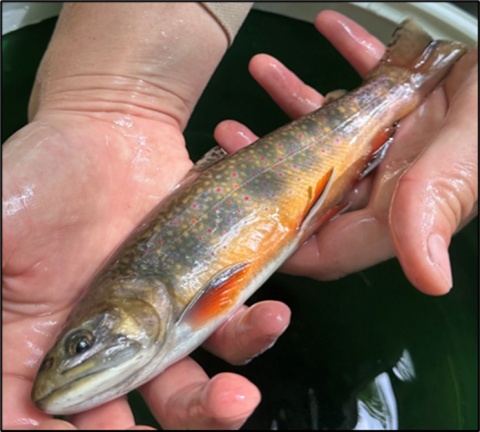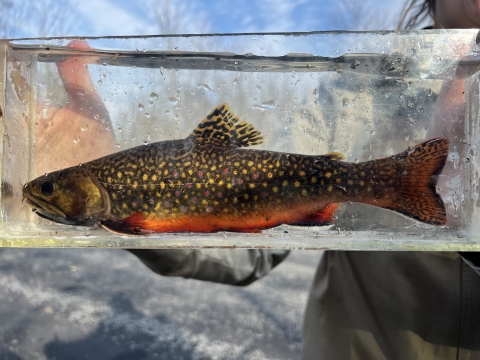Brook trout are often referred to as America’s first sport fishery. In the late 19th and early 20th centuries, people traveled to the United States from all over the world to fish for brook trout. By the mid 1900s, however, brook trout populations had severely declined across their native range — from the Great Lakes basin to the eastern United States. Those declines were caused by a multitude of threats, including degraded habitats, fragmentation from dams and culverts, invasive species invasive species
An invasive species is any plant or animal that has spread or been introduced into a new area where they are, or could, cause harm to the environment, economy, or human, animal, or plant health. Their unwelcome presence can destroy ecosystems and cost millions of dollars.
Learn more about invasive species and poor water quality.
The U.S. Fish and Wildlife Service and our partners have been working together for years to improve water quality, reduce habitat fragmentation, and restore instream and riverbank habitats for brook trout. Monitoring is essential to understanding the effectiveness of these habitat investments. The Brook Trout Monitoring Program, therefore, was launched to provide funding to monitor fish populations and determine how habitat restoration projects have benefitted brook trout.
We made great strides in 2023, in our first full field season, by completing monitoring at 23 sites across the Great Lakes basin.
We established monitoring sites upstream and downstream of proposed stream crossing replacement projects and dam removal projects to measure differences above and below the project site. When evaluating a stream channel restoration or habitat enhancement project, we established monitoring sites upstream of and directly within the area being restored. Using a standardized monitoring protocol that allows for the direct comparison and analysis of data collected by all field offices, all projects were evaluated at least one year pre-construction. Projects will continue to be monitored for at least two years post-construction and the data for each monitoring period compared to evaluate changes in fish communities and habitat condition.
During monitoring, the fish community species diversity and overall condition of the habitat is evaluated and scored at each monitoring site. All brook trout and any other salmonids, such as brown or rainbow trout, captured during the survey were individually measured for length and weight prior to release. All other species were identified, counted, and weighed as a group to determine relative abundance within the system. Habitat and stream channel conditions were evaluated at each project site based on several components including substrate, habitat diversity, and riparian riparian
Definition of riparian habitat or riparian areas.
Learn more about riparian buffer composition and width.
Additionally, we are conducting surveys in historical brook trout rivers and evaluating the habitat, to help us identify where future restoration will have the greatest ecological value for brook trout.
Each stream and geographical area present unique challenges due to terrain, stream size, access, or a combination of factors. Despite these challenges, we are well prepared for the field seasons ahead. Our offices are currently analyzing the data collected in 2023 and will be summarizing the impacts to brook trout across watersheds that drain into the Great Lakes. The data obtained through the monitoring program will be used to learn more about the status of species and help guide restoration efforts.
We are also working with Trout Unlimited and the U.S. Forest Service on monitoring brook trout at their habitat restoration projects. These partners are following the same protocol and collecting comparable data at each project. Additional collaboration with partner organizations provides even greater insight into how these projects affect brook trout across the basin. The collaborative nature of this program highlights an essential part of the Service’s mission—working with others—and ensures one of the Great Lakes Region’s most beloved fish continues to exist for future generations.






